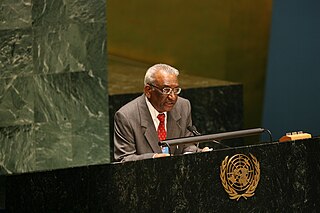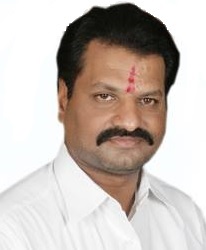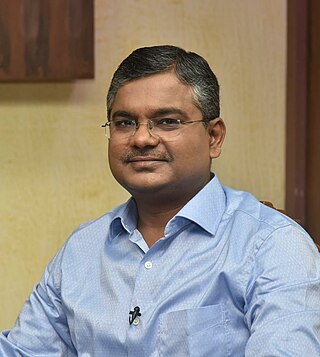Related Research Articles

Dhule is a city located in the Dhule District in the northwestern part of Maharashtra state, India known as West Khandesh. Situated on the banks of Panzara River, Dhule is the regional headquarters of MIDC, RTO, and MTDC.

Solapur is a city located in the south-western region of the Indian state of Maharashtra, close to its border with Karnataka. Solapur is located on major highway, rail routes between Mumbai, Pune, Bangalore and Hyderabad, with a branch line to the cities of Kalaburagi and Vijayapura in the neighbouring state of Karnataka. Solapur International Airport is under construction. It is classified as A1 Tier and B-1 class city by House Rent Allowance (HRA) classification by the Government of India. It is the seventh biggest Metropolis Urban Agglomeration and 11th most populated city in Maharashtra as well as 43rd largest urban agglomeration and 49th most populous city in India.

Belgaum, officially known as Belagavi, is a city in the Indian state of Karnataka located in its northern part along the Western Ghats. It is the administrative headquarters of the eponymous Belagavi division and Belagavi district. The Government of Karnataka has proposed making Belgaum the second capital of Karnataka alongside Bangalore, hence a second state administrative building Suvarna Vidhana Soudha was inaugurated on 11 October 2012.

Alibag, also known as Alibaug, is a coastal city and a municipal council in Raigad district of Maharashtra, India. It is the headquarters of the Raigad district and is south of the city of Mumbai. Alibag is part of the Mumbai Metropolitan Region and is situated at a distance of about 96 km from Mumbai and 143 km from Pune. Alibag is a holy place for Goddess Shree Padmakshi Renuka. She is also known as goddess of Konkan.

Akhil Bharatiya Marathi Sahitya Sammelan is an annual conference for literary discussions by Marathi writers. Marathi is the official language of Maharashtra State. The first Marathi Sahitya Sammelan was held in Pune in 1878 under the chairmanship of Justice Mahadev Govind Ranade.
Lakshman Shastri Joshi was an Indian scholar, of Sanskrit, Hindu Dharma, and a Marathi literary critic, and supporter of Indian independence. Mahatma Gandhi chose him to be his principal advisor in his campaign against untouchability. Joshi was the first recipient of Sahitya Akademi Award in year 1955. He was also awarded with two of the India's highest civilian honours Padma Bhushan in 1973 and Padma Vibhushan in 1992

Abhay Bang and Rani Bang are Indian activists and community health researchers working in the Gadchiroli district of Maharashtra, India.
Ashok Ramchandra Kelkar (1929–2014) was a linguist and critical Marathi writer from Maharashtra, India. He was honoured with the Padma Shri in 2002 and Sahitya Akademi Award for Marathi in 2010.

Dr. Janardan Madhavrao Waghmare is an Indian politician and educationist. He has served as a Member of Parliament in the Rajya Sabha from Maharashtra. He was also the President of the Latur Municipal Council.
Chinawal is a village in the Jalgaon district of Maharashtra state, India. It is situated at the foothills of the Satpura range in a generally hot and dry climate. The densely populated village is surrounded by the flat land and nutrient-rich black soil.
Marathi Language Day is either of the two popular days being celebrated in the Indian state of Maharashtra where Marathi language is primarily spoken.

Nagesh Patil (Shinde) is Shiv Sena politician from Nanded district, Marathwada. He is member of the 13th Maharashtra Legislative Assembly. He represents the Hadgaon Assembly Constituency.
Leena Bhagwat is a Marathi television, theatre, and film actress. She is known for playing the character of Sharayu in Honar Soon Mi Hya Gharchi. She also participated in Fu Bai Fu as a contestant. As of now, she is playing the role of Suvarna Kanitkar in Thipkyanchi Rangoli.

Shri. Sadashiv Martand Garge was a Marathi Writer, Editor, Historian, and Social worker from Pune, Maharashtra, India. He was popularly known by his initials as स. मा..

Vikas Shankar Kharage is an Indian Administrative Service officer currently posted as Additional Chief Secretary to the Chief Minister, Government of Maharashtra since 9 December 2019. He holds additional charge of Principal Secretary of the Department of Cultural Affairs.

All India Institute of Medical Sciences, Nagpur is a medical research public higher education institute located at the Multi-modal International Cargo Hub and Airport at Nagpur (MIHAN), Nagpur, Maharashtra, India. It is one of the four "Phase-IV" All India Institutes of Medical Sciences (AIIMS) announced in July 2014. It is an institution under the Ministry of Health and Family Welfare, which is part of the Government of India.

Bharat Vikas Parishad (BVP) (translation: Indian Development Council) is a member of Sangh Parivar.

Ram Vitthal Satpute is National Vice President of BJYM and a Member of Maharashtra Legislative Assembly elected from Malshiras.

Mangi Khurd is a village of Rajura Taluka Chandrapur District Maharashtra and under Gram panchayat Mangi Bk in Chandrapur District Maharashtra, India
References
- ↑ "Free bus service for rural girl students | Sakal Times". Sakaal. Archived from the original on November 27, 2015. Retrieved 2015-11-26.
{{cite web}}: CS1 maint: unfit URL (link) - 1 2 "244 Buses for Girls Student in Maharashtra". divyamarathi.bhaskar.com. 2014-05-09. Retrieved 2015-11-26.
- 1 2 3 "मानव विकास मिशनच्या अभ्यासिकेचा उजेड पडेना" (in Marathi). Sakal. 2015-10-22. Retrieved 2015-11-26.
- 1 2 3 4 "गतवर्षीच्या तुलनेत यंदा अत्यल्प निधी" (in Marathi). Sakal. 2015-09-30. Retrieved 2015-11-26.
- ↑ "Manav Vikas Mission issue in Hingoli". divyamarathi.bhaskar.com. 2011-06-01. Retrieved 2015-11-26.
- ↑ "तात्पुरत्या तालुक्यांतच अडकले "मानव विकास" चे "मिशन"" (in Marathi). Sakal. 2013-09-12. Retrieved 2015-11-26.
- ↑ "'मानव विकास' शिबिरांना ब्रेक" (in Marathi). Maharashtra Times. 2015-07-10. Retrieved 2015-11-26.
- ↑ "'मानव विकास मिशन'च्या बस सुरू" (in Marathi). Sakal. 2014-06-18. Retrieved 2015-11-26.
- ↑ महाराष्ट्र (2014-06-05). "'मानव विकास'मध्ये उस्मानाबाद, लातूरचा समावेश शक्य" (in Marathi). Loksatta . Retrieved 2015-11-26.